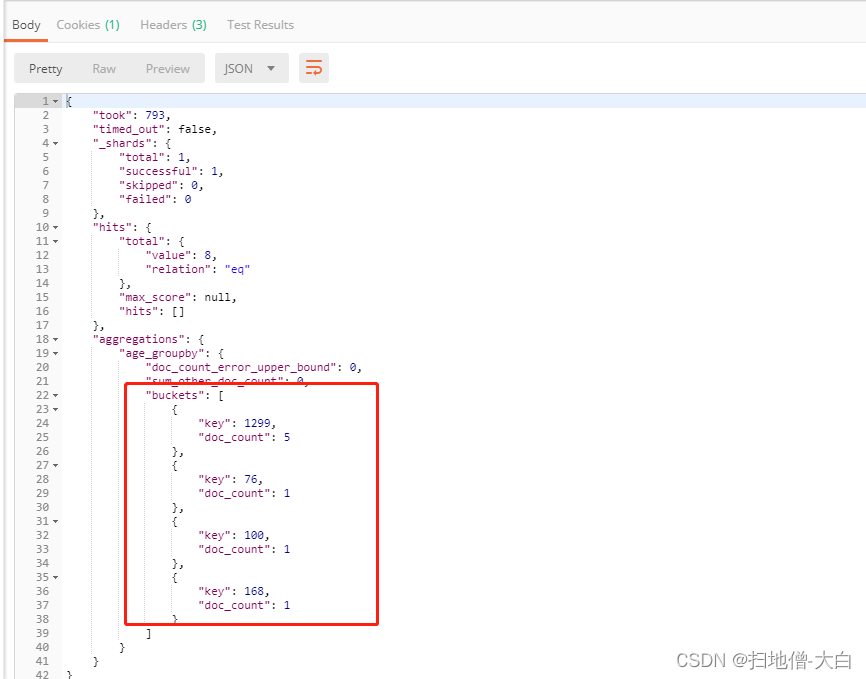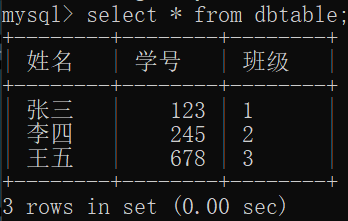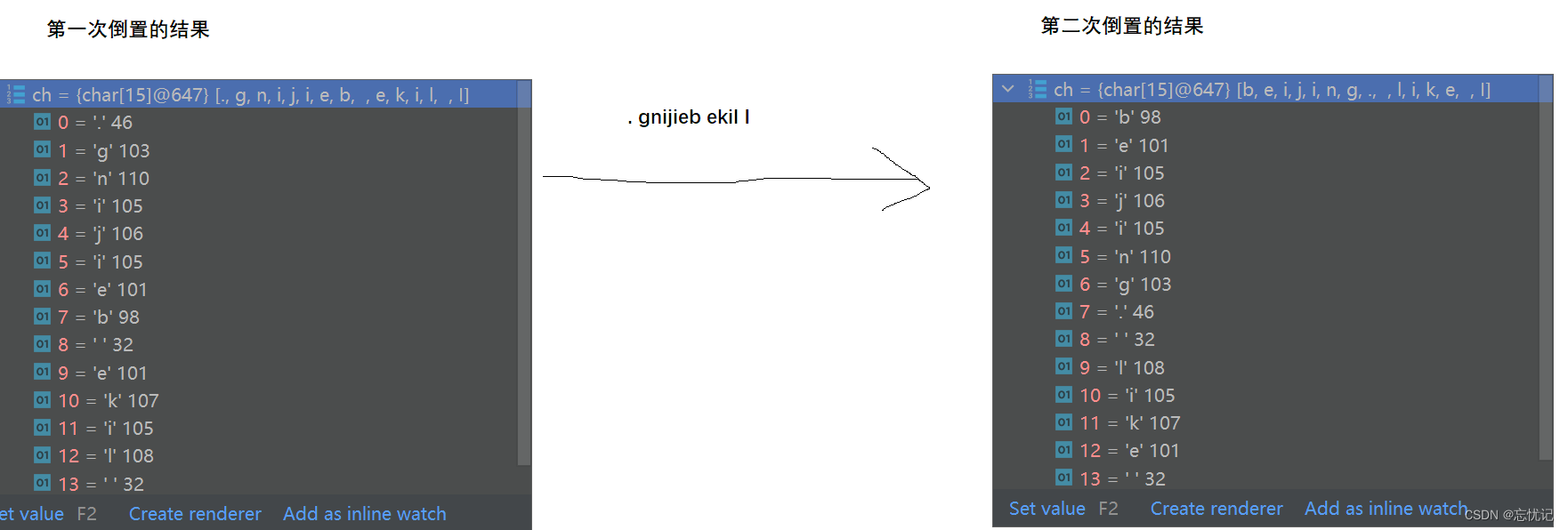目录
一、string 类的模拟实现
1.1 - string.h
1.2 - test.cpp
二、string 类的写时拷贝
2.1 - 示例
2.2 - 原理
一、string 类的模拟实现
1.1 - string.h
#pragma once
#include <assert.h>
#include <string.h>
#include <iostream>
namespace yzz
{
class string
{
public:
/*-------- 构造函数和析构函数 --------*/
// 默认构造函数
string(const char* str = "")
{
assert(str); // 前提是 str 非空
_size = strlen(str);
_capacity = _size;
_str = new char[_capacity + 1];
memcpy(_str, str, _size + 1);
}
// 拷贝构造函数(实现深拷贝)
string(const string& s)
: _size(s._size), _capacity(s._capacity), _str(new char[s._capacity + 1])
{
memcpy(_str, s._str, _size + 1);
// 注意:因为字符串和 string 类对象有所区别,所以此处不能使用 strcpy
}
// 析构函数
~string()
{
if (_str)
{
delete[] _str;
_str = nullptr;
_size = _capacity = 0;
}
}
/*-------- 赋值运算符重载(实现深拷贝)--------*/
// 1. 传统写法
/*string& operator=(const string& s)
{
if (this != &s)
{
delete[] _str;
_str = new char[s._capacity + 1];
memcpy(_str, s._str, s._size + 1);
_size = s._size;
_capacity = s._capacity;
}
return *this;
}*/
// 2. 现代写法
void swap(string& s)
{
std::swap(_str, s._str);
std::swap(_size, s._size);
std::swap(_capacity, s._capacity);
}
/*string& operator=(const string& s)
{
if (this != &s)
{
string tmp(s); // 利用上面写好的拷贝构造函数实现深拷贝
swap(tmp); // 注意:经过交换后,函数结束会析构 tmp
// 正所谓 "兔死狗烹"、"鸟尽弓藏"、"过河拆桥"
}
return *this;
}*/
// 3. 现代写法的改良版
string& operator=(string tmp)
{
swap(tmp);
return *this;
}
/*-------- 容量操作 --------*/
size_t size() const
{
return _size;
}
size_t capacity() const
{
return _capacity;
}
void clear()
{
_str[0] = '\0';
_size = 0;
}
void reserve(size_t n = 0)
{
if (n > _capacity)
{
char* tmp = new char[n + 1];
memcpy(tmp, _str, _size + 1);
delete[] _str;
_str = tmp;
_capacity = n;
}
}
void resize(size_t n, char ch = '\0')
{
if (n > _size)
{
if (n > _capacity) // 考虑是否需要扩容
{
reserve(n);
}
for (size_t i = _size; i < n; ++i)
{
_str[i] = ch;
}
}
_size = n;
_str[_size] = '\0';
}
/*-------- 遍历及访问操作 --------*/
char& operator[](size_t pos)
{
assert(pos < _size); // 前提是 pos 合法
return _str[pos];
}
const char& operator[](size_t pos) const
{
assert(pos < _size); // 前提是 pos 合法
return _str[pos];
}
typedef char* iterator;
typedef const char* const_iterator;
iterator begin()
{
return _str;
}
const_iterator begin() const
{
return _str;
}
iterator end()
{
return _str + _size;
}
const_iterator end() const
{
return _str + _size;
}
/*-------- 修改操作 --------*/
void push_back(char ch)
{
if (_size == _capacity) // 首先判断是否需要扩容
{
reserve(_capacity == 0 ? 5 : 2 * _capacity); // 2 倍扩容
}
_str[_size++] = ch;
_str[_size] = '\0';
}
void append(const char* str)
{
assert(str); // 前提是 str 非空
size_t len = strlen(str);
if (_size + len > _capacity) // 判断是否需要扩容
{
reserve(_size + len); // 至少扩至 _size + len
}
memcpy(_str + _size, str, len + 1);
_size += len;
}
string& operator+=(char ch)
{
push_back(ch);
return *this;
}
string& operator+=(const char* str)
{
append(str);
return *this;
}
void insert(size_t pos, size_t n, char ch)
{
assert(pos <= _size); // 前提是 pos 合法(当 pos 等于 _size 时相当于尾插)
if (_size + n > _capacity) // 判断是否需要扩容
{
reserve(_size + n); // 至少扩至 _size + n
}
// 注意:考虑 pos 为 0 的情况
for (size_t end = _size; end != npos && end >= pos; --end)
{
_str[end + n] = _str[end];
}
for (size_t i = 0; i < n; ++i)
{
_str[pos + i] = ch;
}
_size += n;
}
void insert(size_t pos, const char* str)
{
assert(pos <= _size && str); // 前提是 pos 合法且 str 非空
size_t len = strlen(str);
if (_size + len > _capacity)
{
reserve(_size + len);
}
for (size_t end = _size; end != npos && end >= pos; --end)
{
_str[end + len] = _str[end];
}
for (size_t i = 0; i < len; ++i)
{
_str[pos + i] = str[i];
}
_size += len;
}
void erase(size_t pos = 0, size_t len = npos)
{
assert(pos < _size); // 前提是 pos 合法
if (len == npos || pos + len - 1 >= _size - 1)
{
_size = pos;
_str[_size] = '\0';
}
else
{
for (size_t i = pos + len; i <= _size; ++i)
{
_str[pos++] = _str[i];
}
_size -= len;
}
}
/*-------- 字符串操作 --------*/
const char* c_str() const
{
return _str;
}
size_t find(char ch, size_t pos = 0) const
{
assert(pos < _size); // 前提是 pos 合法
for (size_t i = pos; i < _size; ++i)
{
if (_str[i] == ch)
return i;
}
return npos;
}
size_t find(const char* str, size_t pos = 0) const
{
assert(pos < _size&& str); // 前提是 pos 合法且 str 非空
const char* ptr = strstr(_str + pos, str);
if (ptr)
return ptr - _str;
else
return npos;
}
string substr(size_t pos = 0, size_t len = npos) const
{
assert(pos < _size); // 前提是 pos 合法
size_t n = len;
if (len == npos || pos + len - 1 >= _size - 1)
{
n = _size - pos;
}
string tmp;
tmp.reserve(n);
for (size_t i = pos; i < pos + n; ++i)
{
tmp += _str[i];
}
return tmp;
}
/*-------- 关系运算符重载 --------*/
bool operator==(const string& s) const
{
if (_size != s._size)
return false;
for (size_t i = 0; i < _size; ++i)
{
if (_str[i] != s._str[i])
return false;
}
return true;
}
bool operator!=(const string& s) const
{
return !(*this == s);
}
bool operator<(const string& s) const
{
size_t i = 0, j = 0;
while (i < _size && j < s._size)
{
if (_str[i] < s._str[j])
return true;
else if (_str[i] > s._str[j])
return false;
else
++i, ++j;
}
return i == _size && j != s._size;
}
bool operator<=(const string& s) const
{
return *this < s || *this == s;
}
bool operator>(const string& s) const
{
return !(*this <= s);
}
bool operator>=(const string& s) const
{
return !(*this < s);
}
private:
size_t _size;
size_t _capacity;
char* _str;
public:
static const size_t npos;
};
const size_t string::npos = -1;
/*-------- 流插入(<<)和流提取(>>)运算符重载 --------*/
std::ostream& operator<<(std::ostream& out, const string& s)
{
for (size_t i = 0; i < s.size(); ++i)
{
out << s[i];
}
return out;
}
std::istream& operator>>(std::istream& in, string& s)
{
s.clear(); // 清空 s 中的有效字符
// 清除缓冲区中的空白字符
char ch = in.get();
while (ch == ' ' || ch == '\n' || ch == '\t')
{
ch = in.get();
}
char buf[128] = { 0 };
int i = 0;
while (ch != ' ' && ch != '\n' && ch != '\t')
{
buf[i++] = ch;
if (i == 127) // buf[127] 始终等于 '\0'
{
s += buf;
i = 0;
}
ch = in.get();
}
if (i != 0)
{
buf[i] = '\0';
s += buf;
}
return in;
}
}注意:
'\0' 是字符串的结束标志,因此在输出字符串时,遇到 '\0' 就停止输出了。
而对于 string 类对象,它的成员变量 _size 表示其有效字符个数,因此在输出 string 类对象时,即便遇到 '\0' 也不会停止输出。
示例:
#include <iostream>
#include <string>
using namespace std;
int main()
{
// 输出字符串
const char* str = "Hello\0World";
cout << str << endl; // Hello
// 输出 string 类对象
string s1("Hello");
s1 += '\0';
s1 += "World";
cout << s1 << endl; // HelloWorld
cout << s1.c_str() << endl; // Hello
string s2(s1);
cout << s2 << endl; // HelloWorld
cout << s2.c_str() << endl; // Hello
string s3;
s3 = s1;
cout << s3 << endl; // HelloWorld
cout << s3.c_str() << endl; // Hello
return 0;
}1.2 - test.cpp
#define _CRT_SECURE_NO_WARNINGS 1
#include "string.h"
#include <iostream>
using namespace std;
void test_string1()
{
yzz::string s1;
cout << s1 << endl; // 空
yzz::string s2("Hello");
s2 += '\0';
s2 += "World";
yzz::string s3(s2);
cout << s2 << endl; // HelloWorld
cout << s2.c_str() << endl; // Hello
cout << s3 << endl; // HelloWorld
cout << s3.c_str() << endl; // Hello
yzz::string s4;
cin >> s4; // 假设输入 "abcdef"
cout << s4 << endl; // abcdef
cout << s4.c_str() << endl; // abcdef
yzz::string s5;
s5 = s2;
cout << s5 << endl; // HelloWorld
cout << s5.c_str() << endl; // Hello
}
void test_string2()
{
yzz::string s("hello world");
cout << s.size() << endl; // 11
cout << s.capacity() << endl; // 11
s.clear();
cout << s.size() << endl; // 0
cout << s.capacity() << endl; // 11
s = "hello world";
s.reserve(20);
cout << s.capacity() << endl; // 20
s.resize(5);
cout << s << endl; // hello
cout << s.size() << endl; // 5
cout << s.capacity() << endl; // 20
s.resize(10, 'x');
cout << s << endl; // helloxxxxx
cout << s.size() << endl; // 10
cout << s.capacity() << endl; // 20
}
void test_string3()
{
yzz::string s("01234");
for (size_t i = 0; i < s.size(); ++i)
{
s[i] += 5;
cout << s[i];
}
cout << endl;
// 56789
for (yzz::string::iterator it = s.begin(); it != s.end(); ++it)
{
*it -= 5;
cout << *it;
}
cout << endl;
// 01234
for (auto& ch : s)
{
ch += 5;
cout << ch;
}
cout << endl;
// 56789
}
void test_string4()
{
yzz::string s;
s.push_back('x');
s.push_back('y');
cout << s << endl; // xy
s.append("xy");
cout << s << endl; // xyxy
s += 'x';
s += 'y';
s += "xy";
cout << s << endl; // xyxyxyxy
s.insert(0, 2, 'M');
cout << s << endl; // MMxyxyxyxy
s.insert(6, "NN");
cout << s << endl; // MMxyxyNNxyxy
s.erase(0, 6);
cout << s << endl; // NNxyxy
s.erase(2, 10);
cout << s << endl; // NN
}
void test_string5()
{
yzz::string url("https://legacy.cplusplus.com/reference/string/string/");
size_t begin1 = 0;
size_t end1 = url.find("://", begin1);
yzz::string protocol;
if (end1 != yzz::string::npos)
{
protocol = url.substr(begin1, end1 - begin1);
cout << protocol << endl; // https
}
size_t begin2 = end1 + 3;
size_t end2 = url.find('/', begin2);
yzz::string domainName, uri;
if (end2 != yzz::string::npos)
{
domainName = url.substr(begin2, end2 - begin2);
uri = url.substr(end2 + 1);
cout << domainName << endl; // legacy.cplusplus.com
cout << uri << endl; // reference/string/string/
}
}
void test_string6()
{
yzz::string s1("hello");
yzz::string s2("hello");
yzz::string s3("helloxyz");
cout << (s1 == s2) << endl; // 1
cout << (s1 < s3) << endl; // 1
cout << (s3 > s1) << endl; // 1
}
int main()
{
// test_string1();
// test_string2();
// test_string3();
// test_string4();
// test_string5();
test_string6();
return 0;
}二、string 类的写时拷贝
Scott Meyers 在《More Effective C++》中举了个例子:在你还在上学的时候,你的父母要你不要看电视,而去复习功课,于是你把自己关在房间里,做出一副正在复习功课的样子,其实你在干着别的诸如给班上的某位女生写情书之类的事,而一旦你的父母进来在你房间要检查你是否在复习时,你才真正捡起课本看书。这就是 "拖延战术",直到你非要做的时候才去做。
当然,这种事情在现实生活中时往往会出事,但其在编程世界中摇身一变,就成为了最有用的技术,写时拷贝(Copy-On-Write,简称 COW)技术,就是 "拖延战术" 的产物。
2.1 - 示例
我们可以通过下面的程序来了解 string 类的写时拷贝技术。
#include <string>
#include <stdio.h>
using namespace std;
int main()
{
string s1("hello world");
string s2(s1);
string s3;
s3 = s1;
printf("s1's address:%p\n", s1.c_str());
printf("s2's address:%p\n", s2.c_str());
printf("s3's address:%p\n", s3.c_str());
s1[0] = 'x';
s2[0] = 'y';
s3[0] = 'z';
printf("After Copy-On-Write...\n");
printf("s1's address:%p\n", s1.c_str());
printf("s2's address:%p\n", s2.c_str());
printf("s3's address:%p\n", s2.c_str());
return 0;
}这个程序的输出结果是(测试平台为 Linux):

我们可以看到,当用 s1 构造 s2,以及把 s1 赋值给 s3 时,s1、s2 和 s3 存放数据的地址都是一样的,即共享内存。而共享同一块内存的对象发生内容改变时,触发了 string 类的写时拷贝,s1 和 s2 存放数据的地址发生了改变,s3 存放数据的地址不变。修改内容才触发写时拷贝,不修改内容则不触发,这就是 "拖延战术" 的真谛,非要做的时候才去做。
2.2 - 原理
string 类的写时拷贝是在浅拷贝的基础上增加了 "引用计数" 的方式来实现的。
引用计数:用来记录资源使用者的个数。在构造时,将资源的计数给成 1,每增加一个对象使用该资源,就给计数增加 1,当某个对象被销毁时,先给该计数减 1,然后再检查是否需要释放资源,如果计数为 1,说明该对象是资源的最后一个使用者,于是将资源释放,否则就不能释放,因为还有其他对象再使用该资源。
具体实现思路:
每当我们为 string 类对象分配内存时,我们总是要多分配一个空间用来存放这个引用计数的值,只要发生拷贝构造或者赋值,这个空间的值就会加 1。而在修改 string 类对象时,就会查看引用计数是否为 1,如果不为 1,表示有人在共享这块内存,那么自己需要先做一份拷贝,然后把引用计数减 1。



















